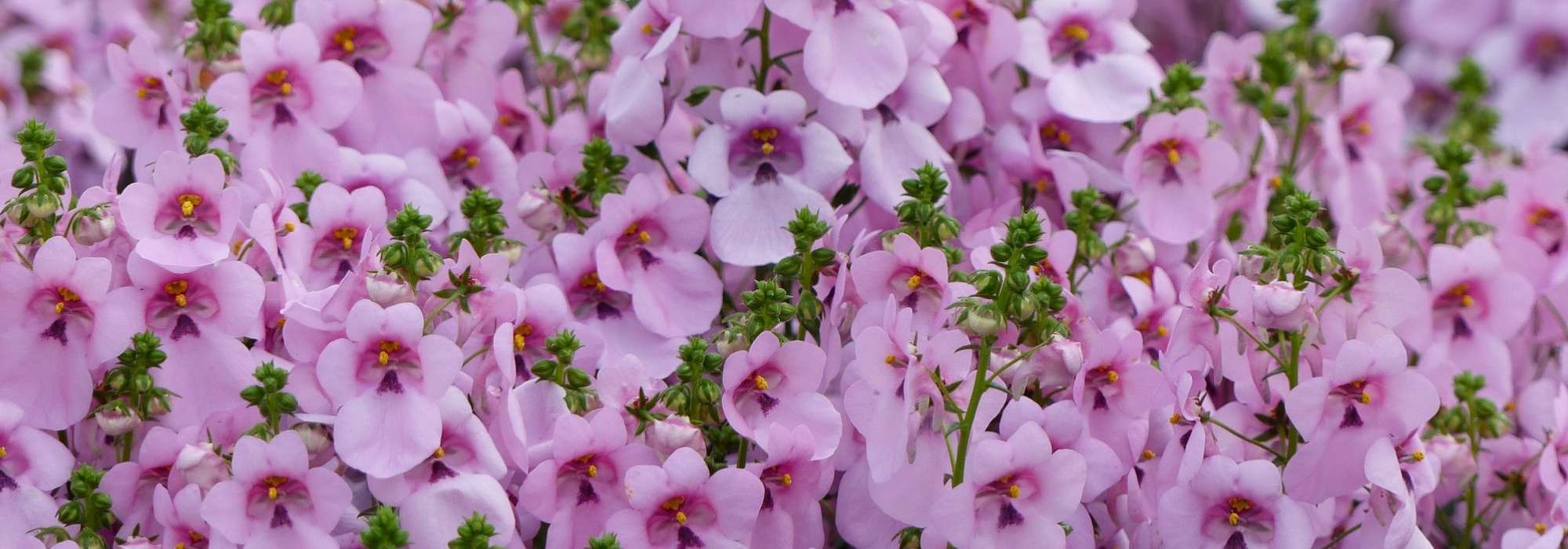
Diascia, twinspur : sowing, planting, growing
Contents
Diascia in a nutshell
- Floriferous and with rapid growth, Diascia offers six months’ flowering from May–June through to November
- Its two-spurred flowers come in soft pinks, purples, whites, or sometimes vivid cherry-red!
- This frost-tender perennial is usually grown in our gardens as an annual, either in open ground or in a pot brought indoors for winter
- An exceptionally easy annual to grow in sun, in any good humus-bearing soil, provided it receives regular watering!
- Upright, carpeting or trailing, Diascia suits every situation: hanging baskets, window boxes, beds or borders
A word from our expert
Le Diascia or Twinspur is a perennial, not very hardy plant, usually grown as an annual, although some species survive well in the ground in milder climates.
Well known for use in hanging baskets and tubs, this fresh plant also dresses borders, rockeries and low-edging.
From the very common Diascia barberae and its cultivars to Diascia fetcaniensis, considered the hardiest, via Diascias cordata, Diascia rigescens, Diascia vigilis or elegans, spreading and creeping species, and the large Diascia personata, an astonishing perennial Diascia that survives in the ground down to at least −8°C, all are appreciated on terraces and in gardens for their flowering in bright or delicate colours which extends from spring through first frosts.
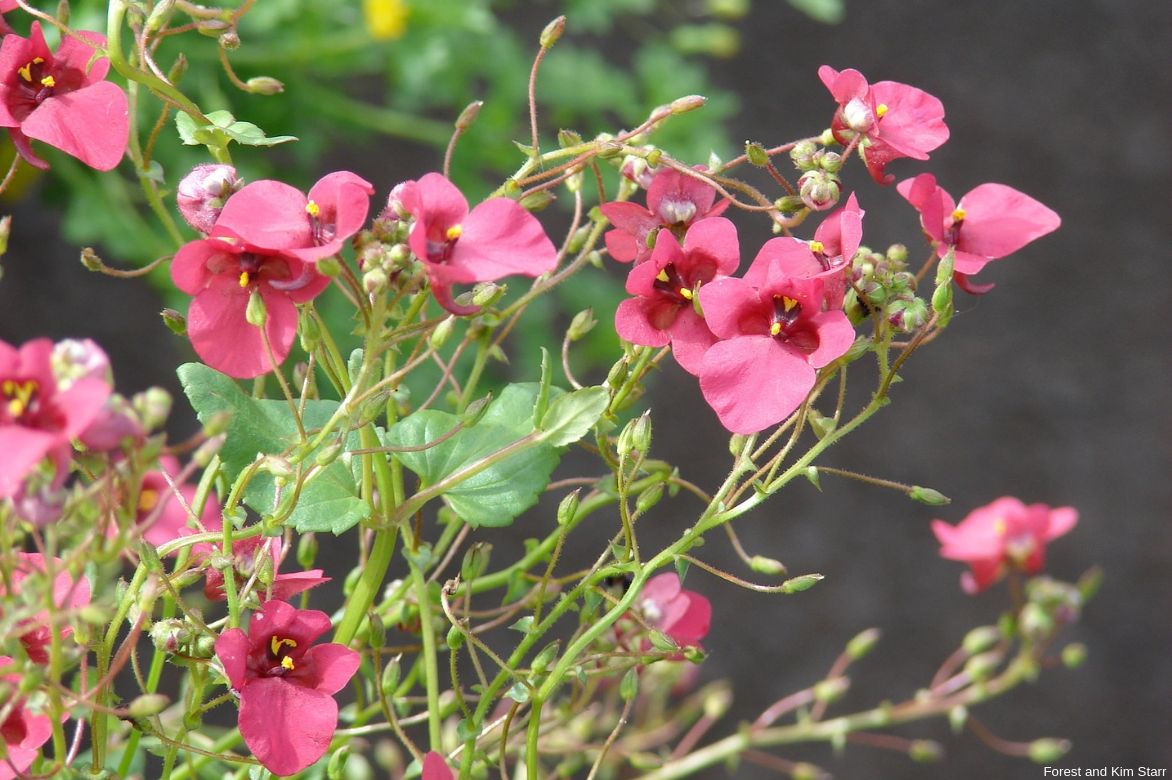
They are perfect for all natural and naturalistic gardens or romantic gardens and suitable for all gardeners, even beginners.
Easy to grow, Diascia thrives in sun, in any good, well-drained garden soil that remains cool, requiring only regular watering to perform at its best.
Discover our collection of Diascias in plug plants as well as our Diascia flower seeds and fall for this pretty annual plant, generous and vigorous to try in not-too-cold areas!
And choose from our unique selection of annual flowers!
Description and botany
Botanical data
- Latin name Diascia
- Family Scrophulariaceae
- Common name Diascia, twinspur
- Flowering May to November
- Height 0.15 to 1 m
- Exposure sun, partial shade
- Soil type cool well-drained
- Hardiness low -5 to -8°C
Diascia or twin spur is a perennial plant native to South Africa belonging to family Scrophulariaceae, like snapdragon. Genus includes about 50 perennial species, most of which are tender and therefore usually grown as annuals in our climates. Among species most commonly seen in gardens is Diascia barberae, which has given rise to numerous cultivars; Diascia fetcaniensis is one of the hardiest species in the genus, Diascia personata is one of the tallest, and Diascia cordata is a spreading species.
Many hybrids have been created, such as Diascia grandiflora, or very floriferous selections like diascias “Genta”.
Habit varies according to species and cultivars; erect, more or less creeping or spreading, semi-trailing to trailing. Multiple cultivars and regular introduction of new varieties increase forms and options for use.
Smallest Diascia varieties do not exceed 0.15–0.30 m in height, while tallest form erect clumps of 0.6–1 m in height, with spread up to 50 cm.
Although growth is rapid, Diascia proves to be a short-lived perennial that needs to be propagated to sustain it in the garden in mild climates.
All form a small compact, highly ramified bush with foliage deciduous to semi-evergreen depending on climate. Shoots, often very flexible, bear small opposite leaves, lanceolate 1–4 cm long, ovate, cordate or tapered, with margins more or less dentate, arranged along the stem bases. Leaves are sometimes covered with a fine down and are medium to dark green.
This delicate foliage is overwhelmed by a shimmering cloud of small flowers. In flower from spring until first frosts, Diascia is notable both for long, very generous flowering and for a beautiful palette of colours, constantly enriched by creation of new varieties.
Stems, erect, semi-erect or prostrate, end in light terminal clusters composed of slightly tubular flowers with 5 fused rounded petals, the lower petal being very broad and the two upper ones extended by two spurs characteristic of Diascia flowers. They resemble snapdragon flowers and occur in all shades of pink, from soft pink to salmon, including peach, apricot, white, and even fiery orange and cherry red. Throat is often subtly highlighted by a small halo of contrasting colour.
This tireless flowering attracts numerous pollinators right up to frosts.
Diascia is a tender perennial that dislikes severe frost (hardy down to about -8°C) and is most often grown as an annual; hardiest diascias will nevertheless survive in the mildest areas. It is easy to grow in sun that is not scorching in any good humus-bearing garden soil, cool and well-drained.
While annual Diascia brightens planters and hanging baskets and is ideal for container culture, its excellent performance also allows planting in open ground, as edging for borders, along paths or in rock gardens.
Main species and varieties
Various species and cultivars of Diascias are prized for their long, generous flowering in a range of colours, often pastel, sometimes vibrant.
Very floriferous, diascias are not always very hardy and some prove less frost-sensitive than others, most disappearing after the first winter. From one species to another, the habit and use vary: erect like Diascia barbarae (perfect for beds and containers), trailing or semi-trailing (ideal for hanging baskets) or tapetum-like such as Diascia cordata (for rockeries and groundcover).
We offer the Diascias Genta from a vigorous, early and very floriferous selection, which has a habit both erect and trailing, allowing multiple uses in beds, borders, groundcover, rockeries, in window boxes, or in hanging baskets !
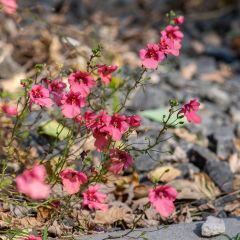
Diascia fetcaniensis
- Flowering time July to December
- Height at maturity 30 cm
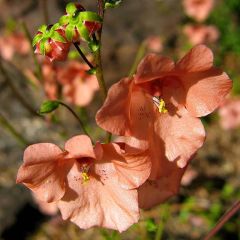
Diascia barberae Blackthorn Apricot
- Flowering time July to December
- Height at maturity 30 cm
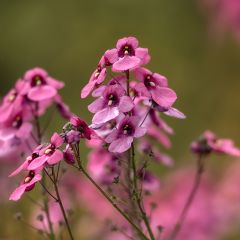
Diascia Breezee Plus Pink
- Flowering time July to November
- Height at maturity 20 cm
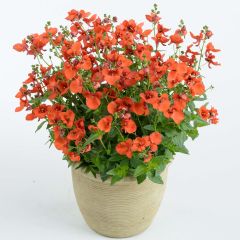
Diascia Breezee Plus Orange
- Flowering time July to December
- Height at maturity 25 cm
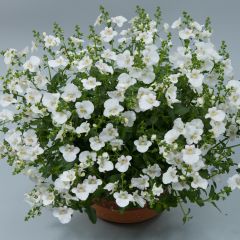
Diascia Breezee Plus White
- Flowering time June to November
- Height at maturity 25 cm
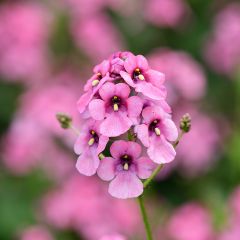
Diascia personata
- Flowering time July to December
- Height at maturity 90 cm
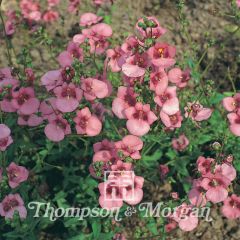
Diascia barberae Rose Queen Seeds - Twinspur
- Flowering time June to November
- Height at maturity 30 cm
Discover other Annual Diascia
View all →Available in 0 sizes
Available in 1 sizes
Available in 1 sizes
Available in 1 sizes
Available in 1 sizes
Available in 1 sizes
Available in 1 sizes
Available in 1 sizes
Available in 1 sizes
Available in 1 sizes
Planting
Where to plant Diascia?
Diascia is a perennial from South Africa with low hardiness! This plant that is sensitive to severe cold and does not withstand temperatures below -8°C to -10°C for the hardiest varieties (such as D. personata et D. fetcaniensis), is usually grown as an annual in open ground or in a pot in our climate. However, it can survive mild winters in the warmest areas of the country, in perfectly drained soil and during fairly short periods of frost.
Because of its relatively low hardiness, outside mild-climate regions it is preferable to grow it in a pot and overwinter it in an unheated room or greenhouse, protected from frost, bringing it out again during the warm season.
Diascia needs a very sunny but not scorching position to flower abundantly. In the south of the country, it will tolerate partial shade. Plant it sheltered from wind. It prefers a rather cool, light, rich and well-drained soil. A good humus-bearing soil that stays fresh will make it thrive! It dislikes overly dry soils and stagnant moisture.
Versatile, depending on its habit—upright, trailing or prostrate—it forms colourful clumps in all naturalistic gardens or romantic gardens, in beds, in borders, to edge a path, in hanging baskets and window boxes or as groundcover on a bank, in borders, rockeries or trailing casually over low walls. It is also a good plant for a conservatory or patio.
When to plant Diascia?
Plant our young Diascias in plug plants in open ground or in pots when frosts are definitely over, in April–May depending on the region. Meanwhile, you can pre-cultivate them in pots to hasten growth, in a warm, bright place (conservatory, greenhouse, cold frame…) at a temperature above 14°C before placing them outside.
How to plant Diascia?
In open ground
Plant about 5 to 6 Diascia plug plants per m², either alone or mixed with other species. Space plants 30 to 40 cm apart in all directions. It thrives in well-draining soil rich in organic matter.
- Soak the buckets for 1 hour before planting
- Dig a hole 2 to 3 times larger than the size of the rootball
- Add gravel or clay pebbles to the base of the planting hole for good drainage
- Mix the excavated soil with a little potting compost and coarse sand
- Place the plug plant in the centre of the hole, without burying the collar
- Bring the soil back around the roots
- Firm down
- Water
Take advantage of our tips to succeed in planting annuals in plug plants
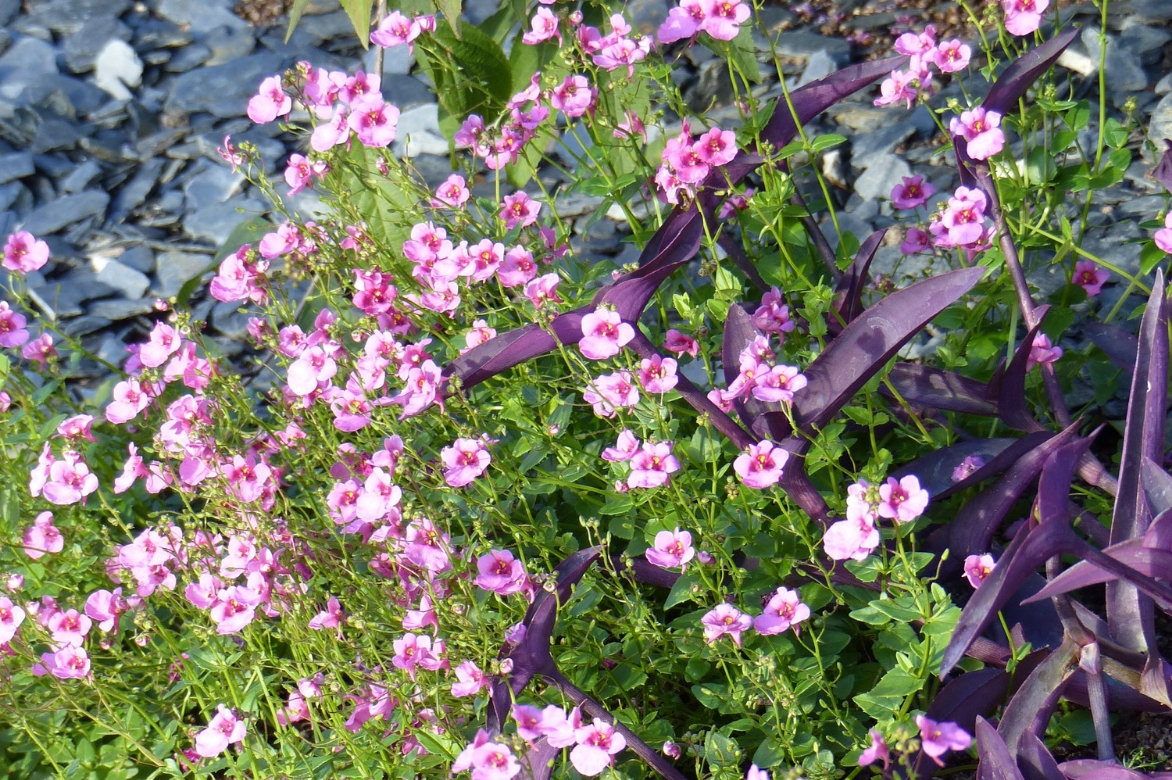
How to plant a diascia in a pot or hanging basket
Diascia is the perfect annual to provide long-lasting colour in hanging baskets and window boxes! Plant in a rich, well-draining mix of geranium-type potting compost alone or mixed with other annuals. All the tips for planting window boxes and hanging baskets with annuals in plug plants are on our blog!
- Use a container at least 15 cm in diameter. When mixed, space plants 15 to 20 cm apart.
- Thoroughly soak the rootballs before planting
- Line the bottom of the container with gravel or clay pebbles
- Plant in potting compost, optionally adding a little river sand
- Fill in and firm
- Water without waterlogging, then water again as soon as the surface dries
- Fertilise regularly and place in sun
When and how to sow Diascia seeds?
Sow Diascia seeds in spring in March–April under cold frame at 16°C, if outside temperatures are still below about 15°C. Choose the Diascia seeds from our nursery.
In seed tray
- Surface-sow on good seed compost
- Keep warm between 18 and 20°C
- Cover seeds lightly to 1.5 mm depth with compost
- Water regularly with fine mist until germination, which generally takes 14 to 21 days
- When young plants have formed 2 or 3 leaves, prick them out into buckets
- Mid-May, after any risk of frost, plant out into soil, in pots or window boxes
In open ground
- Sow Diascia seeds directly, well spaced in furrows, in soil enriched with leaf mould compost, after last frosts, generally in May
- Cover with a fine layer of substrate
- Firm down
- Water and keep soil moist until germination
- Thin out every 10 to 15 cm
Follow our tips to succeed with your annual seed sowings!
Care and maintenance
Le Diascia fait partie de ces plantes annuales très floriferous qui requièrent peu de soins pourvu que la terre reste parfaitement drainée et assez fraîche en été.
To flower abundantly, it needs regular waterings, especially during prolonged dry spells: water every two days but without waterlogging soil, so that it never dries out completely. Water inputs must not be excessive because plant is sensitive to excess moisture, which causes rot at the base.
Mulch to retain moisture at plant base with dry leaves, flax shavings and limit waterings.
For potted specimens, add liquid fertiliser for flowering plants to water every 15 days throughout growth period.
Regularly remove dry leaves and faded flowers to encourage new flowers.
In spring, pinch stems to encourage plant to ramify.
In regions with mild winters, cut clumps back to ground level after flowering then spread a generous dry mulch around base of plant to protect it from frost.
In cold regions from November, lift plants grown in open ground and store pots like conservatory plants in a cool frost-free room to bring out again the following spring.
During winter period, reduce waterings.
Never ill, Diascia is resistant to diseases; it is only threatened by slugs and snails that love its young shoots: discover our advice on how to combat their attacks!

Propagation
Le Diascia is a short-lived tender perennial (3 years) that is worth perennialising: although it survives mild winters in open ground, young plants produced from cuttings taken in summer will be more vigorous. So remember to take cuttings or to divide clumps of suckering species (Diascia fetcaniensis). Sowing is also easy to carry out (follow our advice above!)
How to take cuttings of Diascia?
They are easy to take in spring or in June from semi-woody stems.
- Take 10 cm-long non-flowering stem tips
- Remove lower leaves and cut each stem just below a node
- Plant in buckets filled with potting compost and sand
- Keep substrate moist but without waterlogging until rooting
- Place cuttings in light in an unheated greenhouse over winter
- The following spring, plant them out in ground or in pots in May after last frosts
Dividing clumps of Diascia
- In autumn or spring, with a spade, gently separate clump divisions with roots and a few leaves
- Replant without delay in ground or in pots
- Water to encourage root establishment
Associating
Soft, spreading habit, narrow and airy silhouette, bushy or trailing of Dascia allows numerous uses and combinations. With shades that can be tender and pastel or vivid, it adapts to every desire, in ground or in hanging baskets, in all natural or naturalistic gardens or romantic ones! It is indispensable in wildflower beds, in cottage gardens and pink gardens, to which its cloud-like flowering lends lightness, charm and poetry.
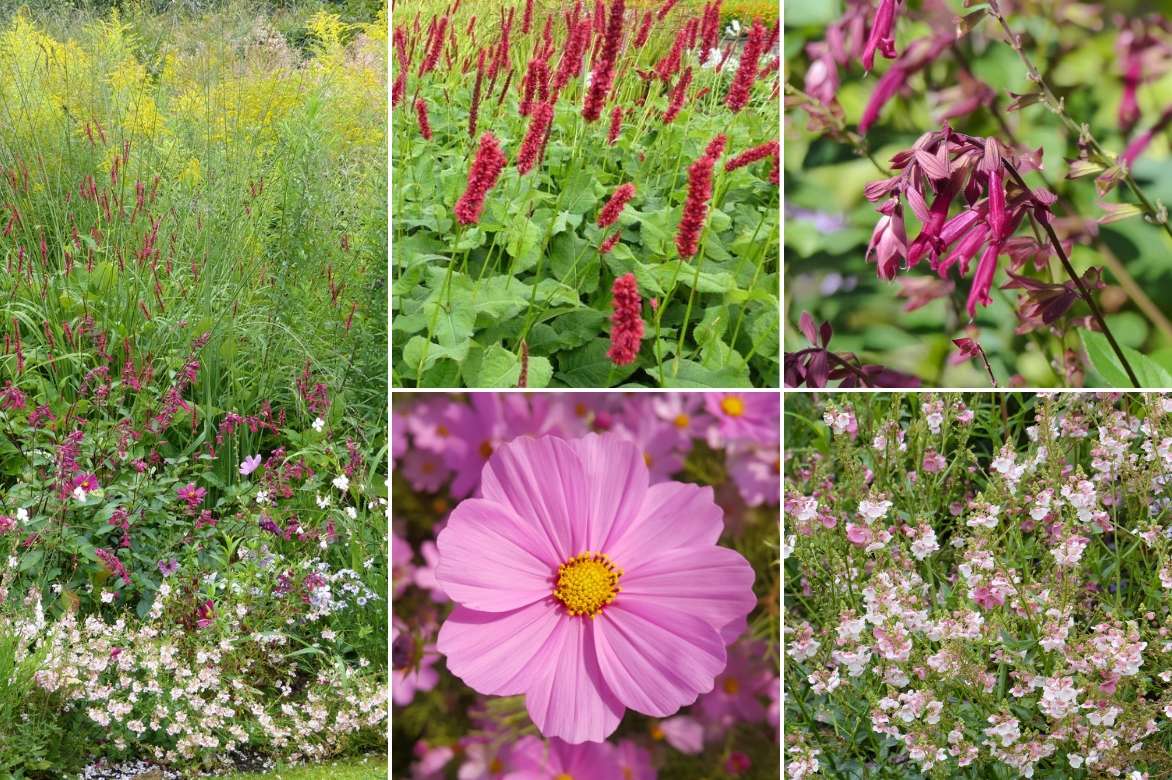
An example of a bed combination: Persicaria amplexicaulis (‘Fat Domino’, ‘Taurus’, ‘Blackfield’…), Salvia ‘Wendy’s Wish’, Cosmos (a mix of ‘Sonata Carmin’ and ‘Sonata Rose Clair’ will be most effective), Diascia (‘Breeze Blue Pastel’ for example) and in the background flowering spikes of Stipa gigantea with a yellow haze of Solidago altissima
Very easy to combine, in pots, mix it with other annuals such as Surfinia petunias, lobelias, morning glories and impatiens.
At front of a border or on an edge, use it mixed with other low-growing plants such as Nemesia, lithodora, sweet alyssum, aubrieta.
Cultivars with pastel flowering will be perfect to enliven borders alongside grey- or electric-blue-leaved plants such as nepeta, cultivars of Helichrysum petiolare, small fescues, hostas or artemisias.
Within a summer bed, plant it in splashes of colour among other pliant plants such as dwarf dahlias, dianthus, fuchsias or verbenas. It will make an impact in a large bed alongside summer-flowering perennials and cottage perennials such as agastaches, asters, penstemons, echinaceas, hardy geraniums or phlox, in which it will entwine beautifully.
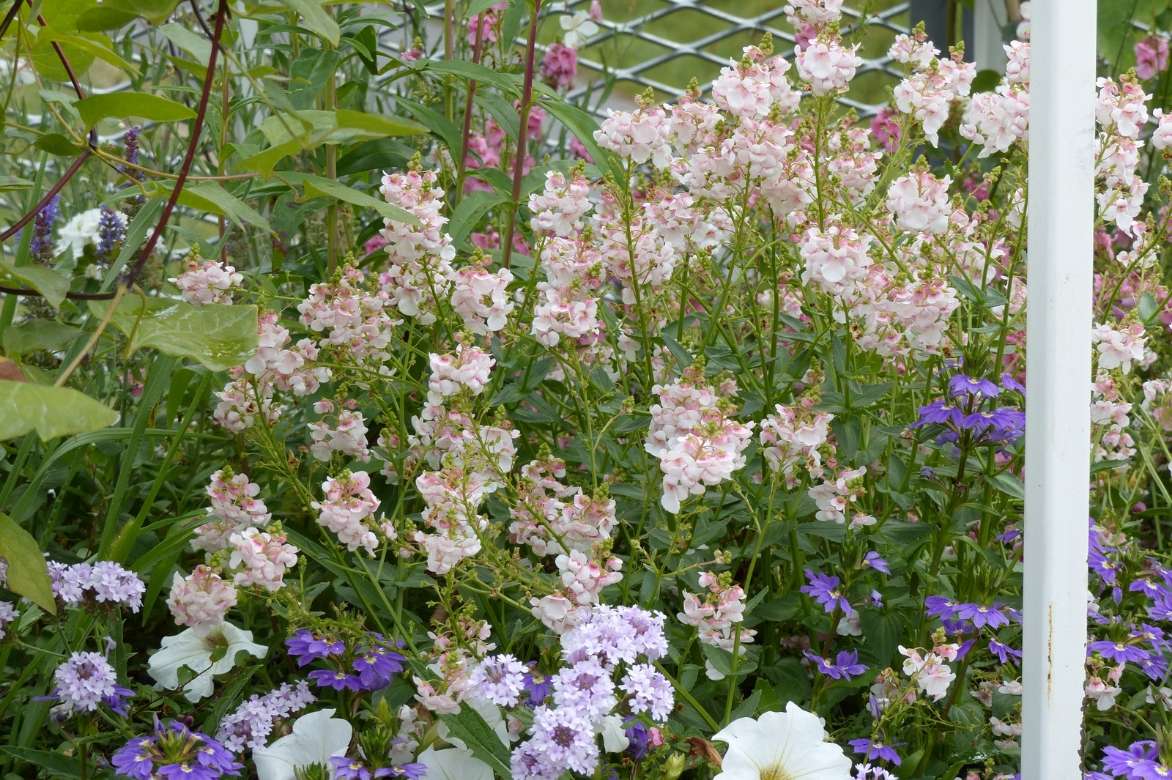
Another example of a combination: Diascia, Verbena rigida ‘Polaris’, Scaevola and Surfinia
It will appreciate company of other annual flowers such as cleomes, cosmos, centaureas and nigellas.
Paired with ivy geraniums and pelargoniums, it will hide bare base of a pink or mauve rose or of a clematis for the whole of the season.
Useful resources
- The most beautiful annual plants are in our nursery!
- Follow all our tips to plant annuals successfully
- With diascia, pink reigns supreme in the garden; get inspired to pair it well in a pink garden!
- Subscribe!
- Contents
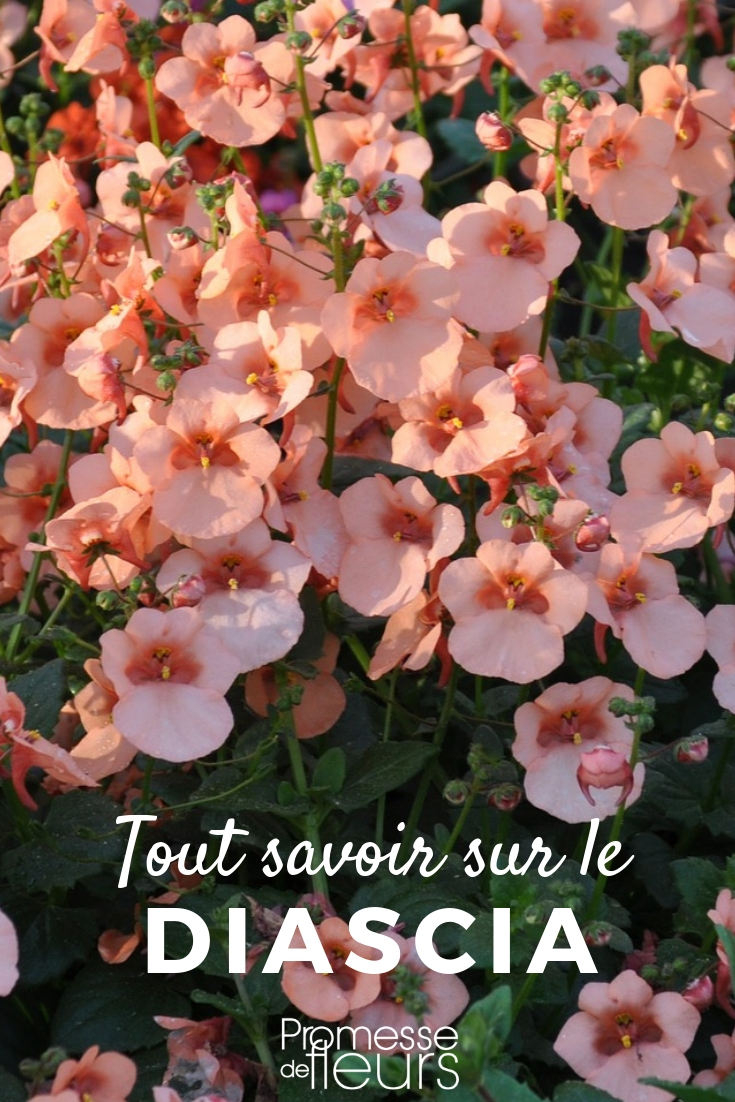































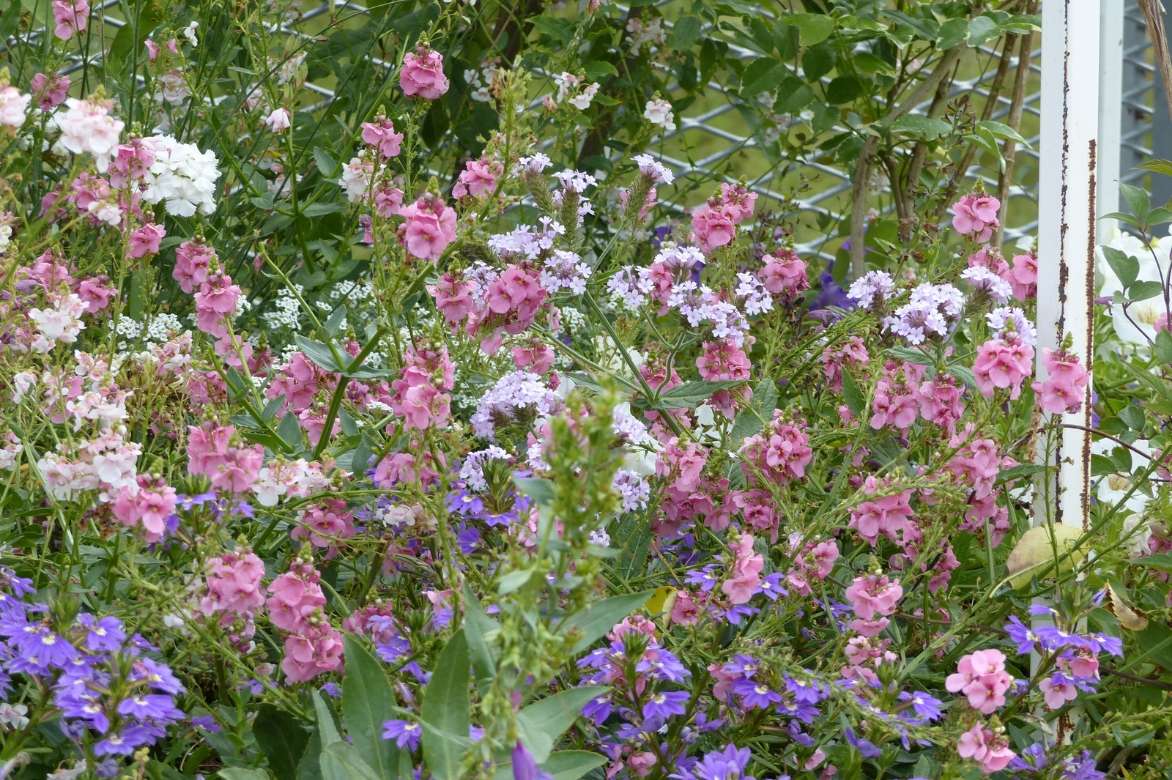
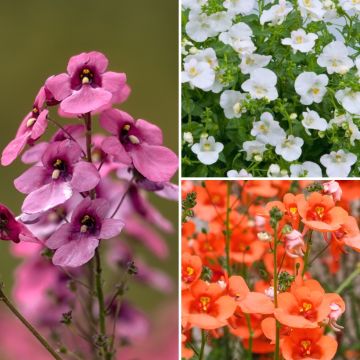
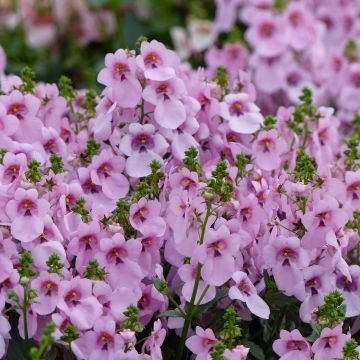


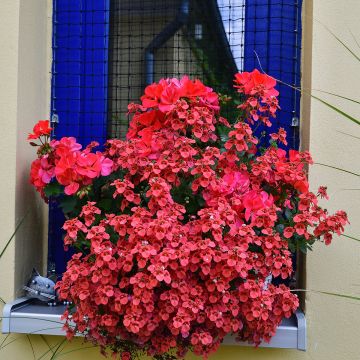
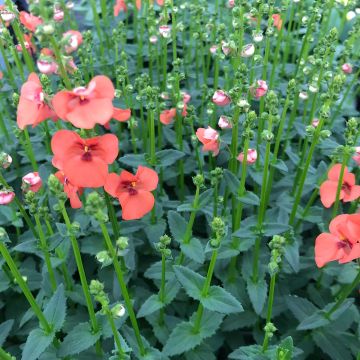

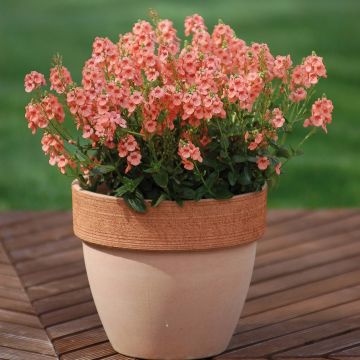
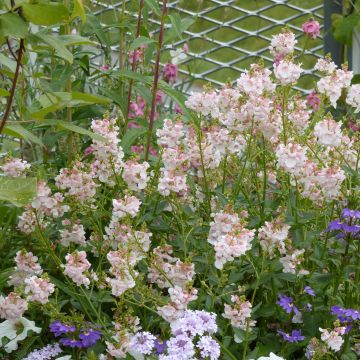
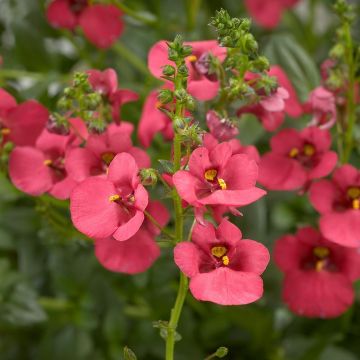
Comments